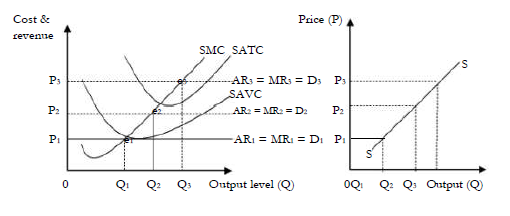The short-run is the period where at least one factor of production must be fixed. The supply curve
will show that when price increases quantity supplied increases (ceteris paribus). To explain the
short-run supply curve of a firm under perfect competition consider the diagrams below:

In the diagram above, the firm is in equilibrium at the point where MC = MR. Suppose that price is
OP1 the firm will be at equilibrium at point e1 where MR1 = MC producing output OQ1 . If the
price was to increase from OP1 to OP2 the demand curve will shift upwards from D1 to D2 and the
firm will be at equilibrium where MR2 = MC producing output OQ2 (output level increase from
OQ1 to OQ2 ).
If the price would further increase from OP2 to OP3 the demand curve will shift further upwards from D2 to
D3 and the firm will be at equilibrium at point e3 where MR3 = MC producing output OQ3 .
Thus as price increases from OP1 to OP2 to OP3 output level increases from OQ1 to OQ2 to Q3 .
If price was to fall below OP1 the firm would close down because it would not be covering its average
variable costs and the output would be zero.
Therefore, in the short-run in a perfectly competitive market, a firms short-run supply curve would be the
marginal cost curve above the average variable cost curve i.e. from point e1 upwards as represented by the SS
curve.
Wilfykil answered the question on
February 6, 2019 at 09:11